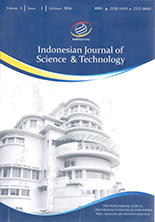Measurement and Quantitative Analysis of Ozone Generation in Radiation Treatment Room Due to High-Energy Photon
Abstract
Keywords
Full Text:
PDFReferences
Yang, P., Xu, T., Gomez, D. R., Deng, W., Wei, X., Elhalawani, H., Jin, H., Guan, F., Mirkovic, D., Xu, Y., Mohan, R., and Liao, Z. (2019). Patterns of local-regional failure after intensity modulated radiation therapy or passive scattering proton therapy with concurrent chemotherapy for non-small cell lung cancer. International Journal of Radiation Oncology, Biology, Physics, 103(1), 123-131.
Kharofa, J., Mierzwa, M., Olowokure, O., Sussman, J., Latif, T., Gupta, A., Xie, C., Patel, S., Esslinger, H., Mcgill, B., Wolf, E., and Ahmad, S. A. (2019). Pattern of marginal local failure in a phase II trial of neoadjuvant chemotherapy and stereotactic body radiation therapy for resectable and borderline resectable pancreas cancer. American Journal of Clinical Oncology, 42(3), 247-252.
Liu, Q., Liu, T., Chen, Y., Xu, J., Gao, W., Zhang, H., and Yao, Y. (2019). Effects of aerosols on the surface ozone generation via a study of the interaction of ozone and its precursors during the summer in Shanghai, China. Science of the Total Environment, 675, 235-246.
Cramariuc, R., Velisar, I., Milevschi, V., and Munteanu, V. (1998). New considerations of ozone generation and the influence of NO~x in ozone production and water treatment. NATO Science Series 2: Environment Security, 63, 313-340.
Botta, C., Ferrocino, I., Cavallero, M. C., Riva, S., Giordano, M., and Cololin, L. (2018). Potentially active spoilage bacteria community during the storage of vacuum packaged beefsteaks treated with aqueous ozone and electrolysed water. International Journal of Food Microbiology, 266, 337–345.
McDonnell, W. F., Stewart, P. W., and Smith, M. V. (2010). Prediction of ozone-induced lung function responses in humans. Journal of the Inhalation Toxicology, 22(2), 160-168.
Bennett, W. D., Hazucha, M. J., Folinsbee, L. J., Bromberg, P.A., Kissling, G. E., and London, S. J. (2007). Acute pulmonary function response to ozone in young adults as a function of body mass index. Journal of the Inhalation Toxicology, 19(14), 1147-1154.
Adams, W. C. (2002). Comparison of chamber and face-mask 6.6-hour exposures to ozone on pulmonary function and symptoms responses. Journal of the Inhalation Toxicology, 14(7), 745-764.
Schultheis, A. H., Bassett, D. J., and Fryer, A. D. (1994). Ozone-induced airway hyper responsiveness and loss of neuronal M2 muscarinic receptor function. Journal of Applied Physiology, 76(3), 1088-1097.
Pavelin, E.G, Johnson, C.E, Rughooputh, S, and Toumi, R. (1999). Evaluation of pre-industrial surface ozone measurements made using Schonbein's method. Atmospheric Environment, 33(6), 919.
Chung, H. K., Bellamy, H. S., and Dasgupta, P. K. (1992). Determination of aqueous ozone for potable water treatment applications by chemiluminescence flow-injection analysis. A feasibility study, Talanta, 39(6), 593-598.
McCully, K. S. (2019). Homocysteine, thioretinaco ozonide, and oxidative phosphorylation in cancer and aging: A proposed clinical trial protocol. Methods in Molecular Biology, 1866, 285-310.
Francis, M., Groves, A. M., Sun, R., Cervelli, J. A., Choi, H., Laskin, J. D., and Laskin, D. L. (2017). Editor's highlight: CCR2 regulates inflammatory cell accumulation in the lung and tissue injury following ozone exposure. Toxicological Sciences, 155(2), 474-484.
Kim, W. S. (2014). Citizen's health impact and countermeasures of high concentration ozone. The Seoul Institute Policy Report, 171, 1-20.
Kwak, Y. K., Yoon, I. K., Lee, J. H., Yoo, S. H. (2009). Consideration about ozone generation in the treatment room while treating a patient. The Journal of Korean Society for Radiation Therapy, 21(2), 75-82.
DOI: https://doi.org/10.17509/ijost.v10i2.82093
Refbacks
- There are currently no refbacks.
Copyright (c) 2025 Universitas Pendidikan Indonesia

This work is licensed under a Creative Commons Attribution-ShareAlike 4.0 International License.
Indonesian Journal of Science and Technology is published by UPI.
View My Stats





















